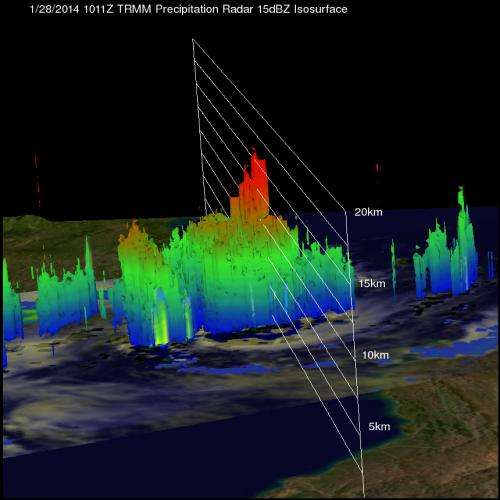TRMM satellite peers at rainfall in developing low near Mozambique

The TRMM satellite flew above a System 91S, a tropical low pressure area, in the Mozambique Channel on January 28, 2014 at 1011 UTC/5:11 a.m. EST. TRMM data collected with this pass may be helpful in evaluating this low for possible tropical cyclone formation.
An analysis of rainfall from TRMM's Microwave Imager (TMI) and Precipitation Radar (PR) instruments are shown on the left overlaid on a visible/infrared image from TRMM's Visible and InfraRed Scanner (VIRS). TRMM PR measured rain falling at the rate of over 134.9 mm/~5.3 inches per hour in a band of powerful convective thunderstorms north of the center of circulation.
A 3-D view was created at NASA's Goddard Space Flight Center in Greenbelt, Md. using TRMM PR data. That image showed that some towering storms near the center of the low were reaching heights of above 16 km/9.9 miles. Towers this tall near the center of the tropical low are often an indication of tropical cyclone formation or intensification.
On January 29 at 1430 UTC/9:30 a.m. EST, the Joint Typhoon Warning Center dropped System 91S from formation alert status, but the low pressure area still has a medium chance for development in the next 24 hours. System 91S was located near 18.2 south and 39.1 east, about 585 nautical miles northeast of Maputo, Mozambique. An image from India's Oceansat satellite indicated 20 to 25 knot (37.0 to 46.3 kph/23.0 to 28.7 mph winds over the eastern semi-circle of the storm. Meanwhile the NOAA-19 polar orbiting satellite data showed weak, shallow convective banding of thunderstorms wrapping into the low-level center on January 29.
System 91S is located in an environment with moderate vertical wind shear. The Joint Typhoon Warning Center noted that dynamic computer model guidance shows System 91S should weaken as it continues moving to the southwest.
Only one named tropical cyclone called Deliwe has passed through the Mozambique Channel so far this year but this analysis found that areas of the Mozambique Channel from southeastern Mozambique through western Madagascar have already had well above normal rainfall for the past 30 days.
Provided by NASA's Goddard Space Flight Center




















